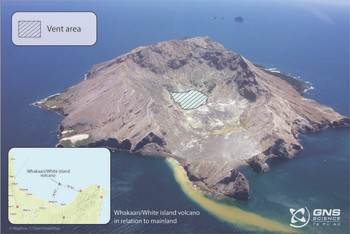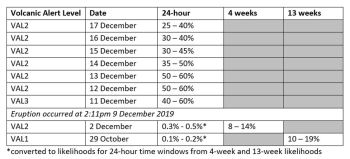
Whakaari/White Island likelihood of future eruption: Update #7
Expert judgement this morning is that there is a 25-40% chance (unlikely) of an eruption occurring that could impact the area beyond the vent within the next 24 hours. The lower bound of this range has decreased slightly compared to yesterday.
What happened?
On Monday 9 December at 2:11pm an eruption occurred at Whakaari/White Island, with devastating impacts for people on the island at the time, their families, and wider New Zealand.
Future scenario
At 11:00 am 17 December, GNS Science volcanologists reviewed all available data and updated the likelihood of an eruption. Their updated calculation was that there is a 25-40% chance (unlikely) of an eruption occurring that could impact the area beyond the vent (marked in the image below) within the next 24 hours.
Click image to make it larger. The distance between the edge of the crater lake and the ocean at the bottom of the image is about 700m.
How does this compare to previous estimates?
The lower bound of the likelihood of an eruption has decreased slightly since yesterday (Monday 16 December 2019).
The table above shows the expert judgement of eruption likelihoods for time periods before and after the eruption. The table shows that the likelihood of an eruption is now about 100 times higher than in early December.
About our expert judgements
Our scientists calculate eruption likelihoods via expert judgement as part of internal staff health and safety procedures for all volcanoes at Volcanic Alert Level 1 or higher. The time periods used for the expert judgements vary depending on the level of activity at the volcano – when activity increases, we do expert judgements more often and for a shorter time window to reflect the changing situation.
Since the eruption on 9 December, eruption likelihoods have been calculated for a 24-hour time period. For 29 October and 2 December (before the eruption), eruption likelihoods were calculated for 4-week and 13-week time windows respectively and have been converted in this table to reflect relevant 24-hour time windows for comparison.
We appreciate that the likelihoods may seem high given (at time of writing) there have been no further eruptions at Whakaari since 9 December. Every day, our team of experts has reviewed all available data and discussed processes likely to be underway at the volcano. Our experts have identified several factors that could lead to an eruption (see VAB), all of which are difficult to forecast. There is considerable uncertainty around the likelihood of any of these factors occurring within a 24-hour period. This ongoing uncertainty is accounted for in our expert judgement and contributes to why the likelihood remains high. Although the volcano is quieter, the likelihood remains unusually elevated.
The Volcanic Alert Level is not linked directly to risk and likelihoods but describes the level of current volcanic activity.
Attributable to: Natalia Deligne, GNS Science Volcanic Hazard and Risk Modeller
Media contact: 021 574 541 or media@gns.cri.nz

